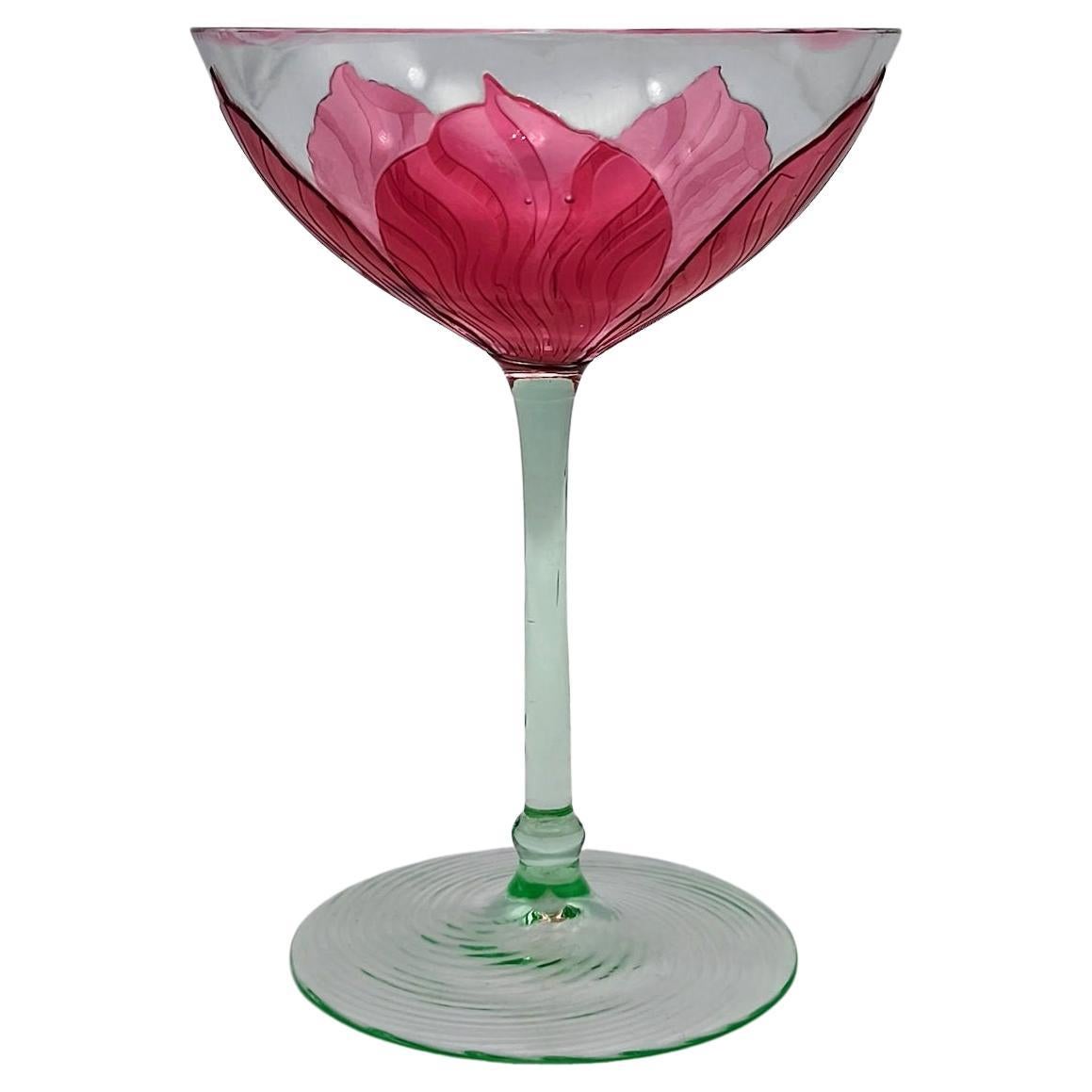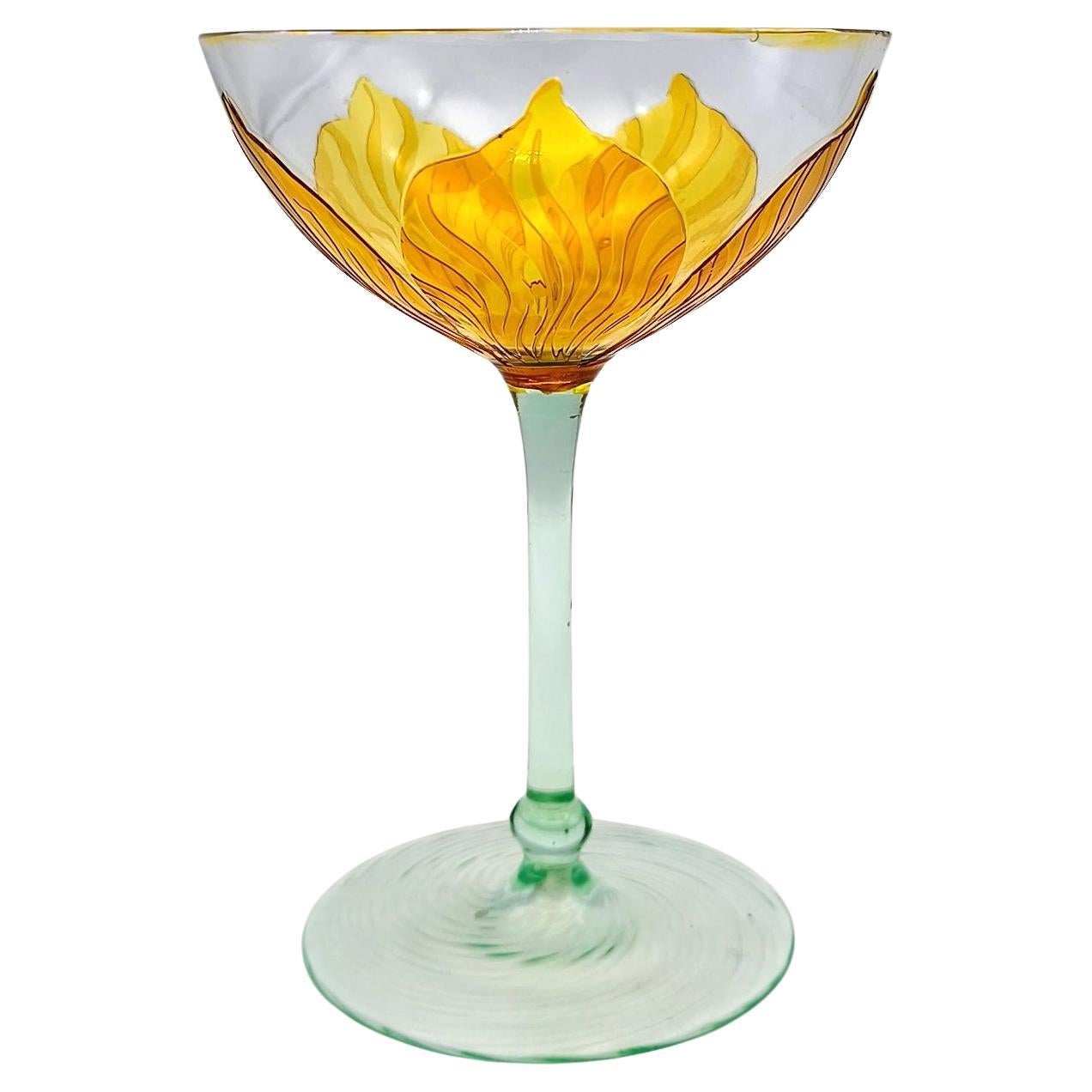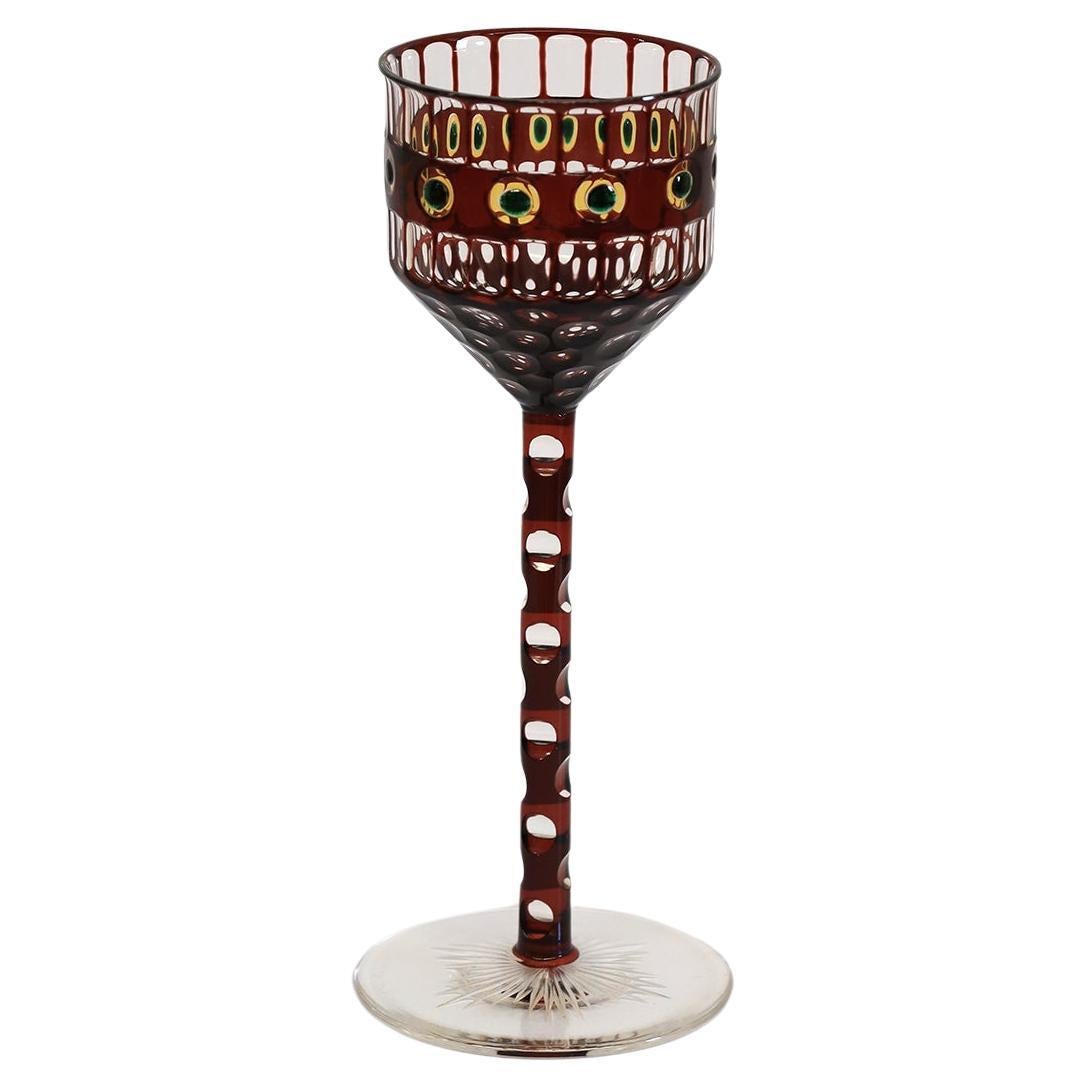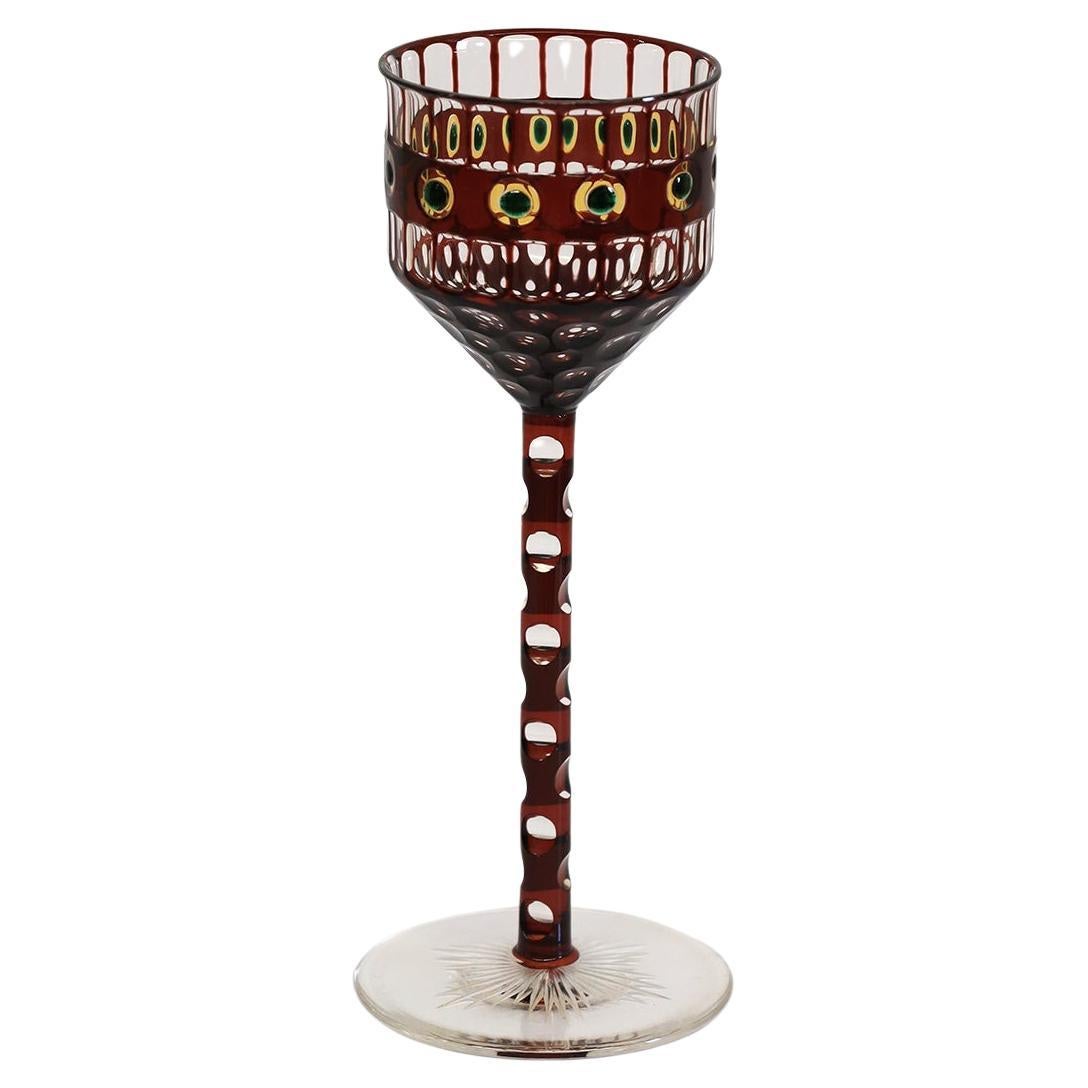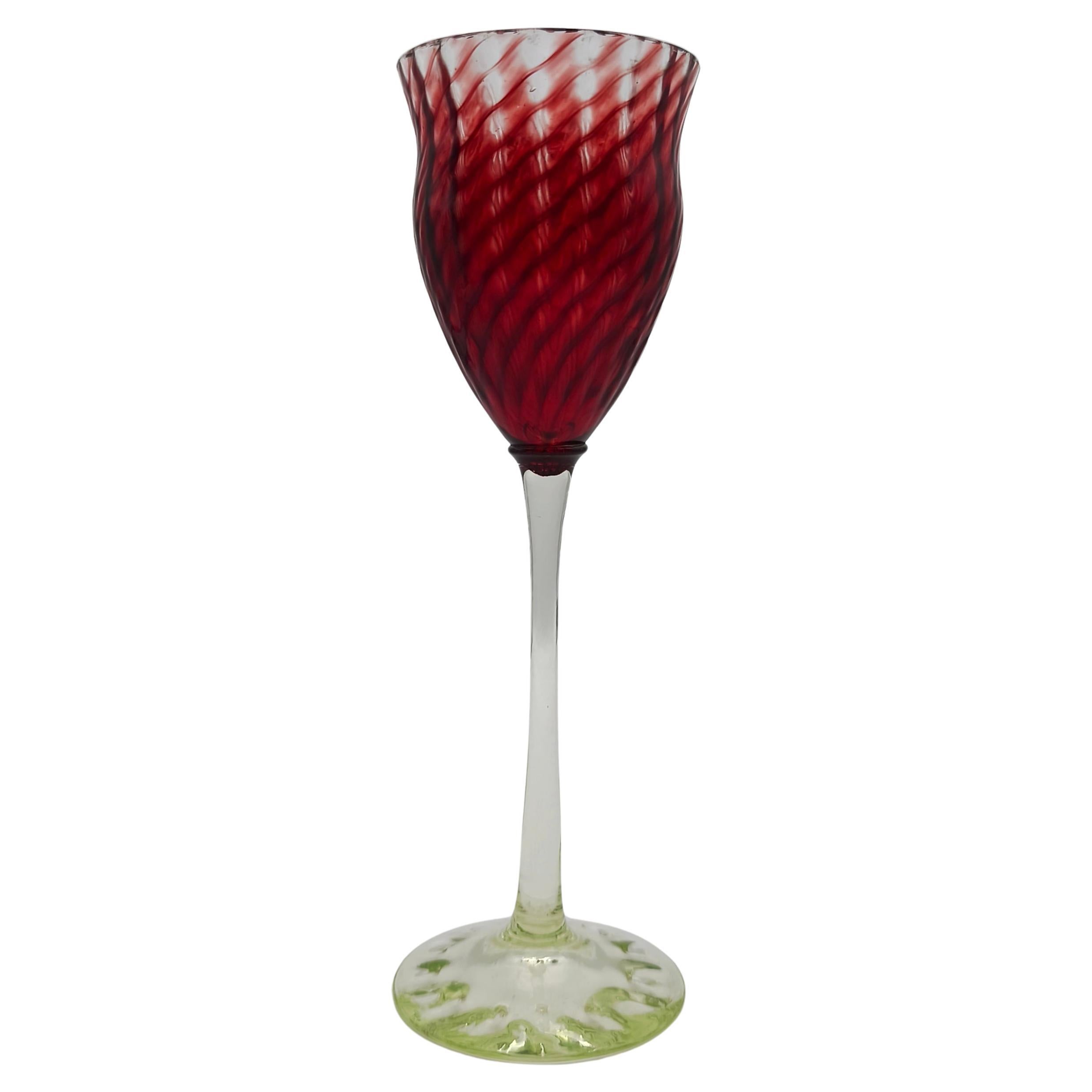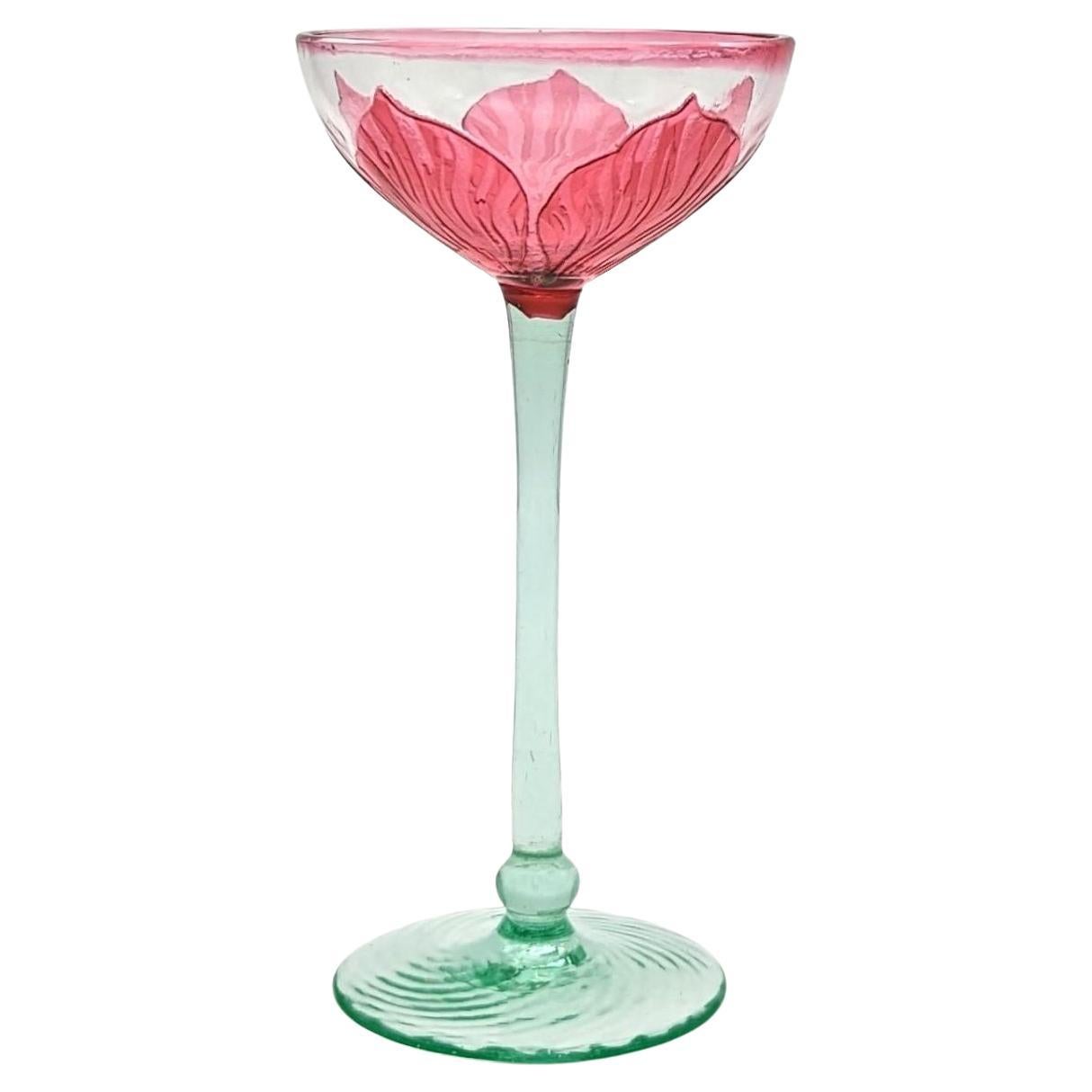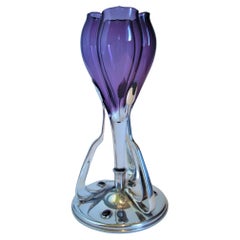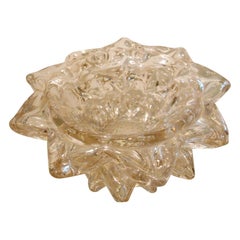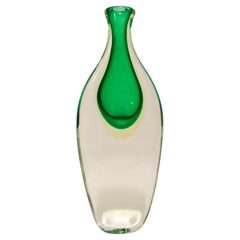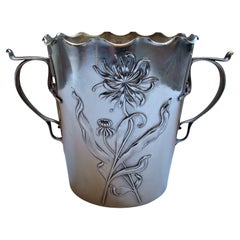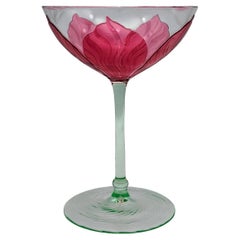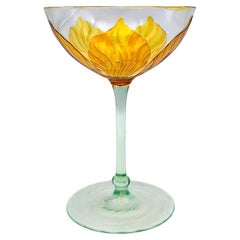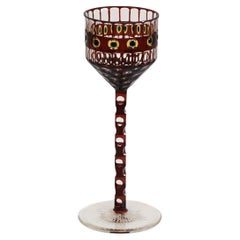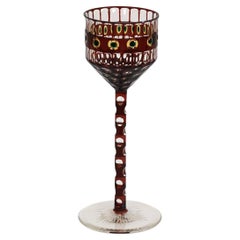Items Similar to Wine Glass Art Nouveau Design Otto Prutscher by Meyr's Neffe Adolf Bohemia 1907
Want more images or videos?
Request additional images or videos from the seller
1 of 9
Wine Glass Art Nouveau Design Otto Prutscher by Meyr's Neffe Adolf Bohemia 1907
$6,999
£5,346.55
€6,142.64
CA$10,007.07
A$11,025.45
CHF 5,707.44
MX$132,749.33
NOK 72,270.04
SEK 67,893.13
DKK 45,866.52
About the Item
Red Wine Glass Art Nouveau Design Otto Prutscher by Meyr's Neffe Adolf Bohemia 1907. Fantastic Red Glass by Otto Prutscher. Extraordinary collectible Drinking Glass in perfect condition.
Vienna Secession
EXCELLENT CONDITION / There aren't any damages existing !
Founded in 1903, the Wiener Werkstätte, or Vienna Workshop, produced finely handcrafted objects for daily use. Established as a cooperative of artisans, the group was led by the architect Josef Hoffmann and other pioneering modernists who sought to unify the fine and applied arts as a Gesamtkunstwerk (total work of art). Due to its emphasis on handcraftsmanship and luxury materials and processes, however, the Wiener Werkstätte’s designs were only accessible to an upperclass clientele. Although the Wiener Werkstätte had no prescribed style, simple squares, rigorous geometries, and abstracted floral designs were common motifs. Applied across a range of functional and decorative objects, they can be seen here in the Hoffmann-designed vase and container, alongside wineglasses by his former student Otto Prutscher.
We have specialized in the sale of Art Deco and Art Nouveau and Vintage styles since 1995. If you have any questions we are at your disposal. Pushing the button that reads 'View All From Seller'. And you can see more objects to the style for sale. Why are there so many antiques in Argentina?
In the 1880 – 1940 there was a grate wave of immigration encouraged by the periods of war that were taking place. 1st World War took place between 1914 and 1918 2nd World War took place between 1939 and 1945 The immigrants options were New York or Buenos Aires. Tickets were cheap and in Buenos Aires they were welcomed with open arms, as it was a country where everything was still to be done. Argentina was the country of new opportunities, labour was needed and religious freedom was assured, in many cases the of the family travel first until they were settled and then the rest of the family members join them. In the immigrant museum “Ellis Island Immigrant Building” in New York you can se the promotional posters of the boats that would take them to a new life. Between the years 1895 and 1896, Argentina had the highest DGP (gross domestic product) per capita in the world according to the Maddison Historical Statistics index, this situation arose due to the large amount of food being exported to European countries, which were at war. The Argentinean ships left the port of Buenos Aires with food, but they returned with furniture, clothes and construction elements, (it´s common to see this the old buildings of the historic neighbourhood of San Telmo, the beams with the inscription “Made in England)”, as well as many markets that were built in Buenos Aires, such us the San Telmo Market, whose structure was brought by ship and afterwards assembled in 900 Defensa Street. With the great influence of European immigrants living in the country, the children of the upper classes travelled to study in France, resulting in the inauguration of “La Maison Argentinienne”, on 27th of June 1928, in the international city of Paris, which hosted many Argentinians that were studying in Frace. It´s the fourth house to be built after France, Canada and Belgium, being the first Spanish-speaking one. Still in place today (17 Bd Jourdan, 75014, Paris, France). Many of the children of these wealthy families who attended international art exhibitions, museums and art courses abroad, took a keen interest in the European style. This is why Buenos Aires was at the time referred as “The Paris of South America”. Between the years 1890 and 1920 more than a hundred Palaces were built on Alvear Avenue the most exclusive avenue in Buenos Aires. Today some of these palaces have been transformed into museums, hotels and embassies. In the year 1936, the Kavanagh building was inaugurated, it was the tallest reinforced concrete building in South America. During 1994 the American Society of Civil Engineers distinguished it as an “international engineering milestone”, and it´s now considered a World Heritage of Modern Architecture. At the time was common to hire foreign architects such as Le Corbusier, who visited Buenos Aires/Argentina in 1929 and in 1948 he drew up the blueprints for a house built in La Plata City (which was declared a World Heritage Site). In 1947, the Hungarian architect Marcelo Breuer designed “Parador Ariston” in the seaside city of Mar del Plata. After an Argentinean student at Harvard University convinced him to come to Argentina. He worked on an urban development project in the Casa Amarilla, area of La Boca. The Ukrainian architect, Vladimiro Acosta, arrives in Argentina in 1928 and worked as an architect until que moved to Brazil. Antonio Bonet, a Spanish architect who worked with Le Corbusier in Paris, arrives in Argentina in 1937, where he carried out several architectural works and in 1938 designs the well-known BFK chair. Andres Kálnay, of Hungarian origin, made around 120 architectural masterpieces, among which the former Munich brewery stands out, he even made the furniture’s design. The German architect, Walter Gropius, director of the Bauhaus, lived in Argentina, where he wrote articles for “Sur” magazine and founded in Buenos Aires, an architectural firm with Franz Möller, who was also an architect, where he built two houses. At the same time several famous designers decided to immigrate to Argentina, among them we can find the well-known French designer, Jean-Michel Frank, who arrived in the country in 1940 and also worked for the Rockefeller family. Special pieces were made, which were sold exclusively in the country, such as the well-known German company “WMF”, who sold their products by catalogue, which were chosen by the ladies of high society in the list of wedding gifts, as well as the pieces designed by Christofle. The Swiss sculptor Alberto Giacometti, made special pieces for Argentinean mansions. In 1904 the first Jansen branch outside Paris was established in Buenos Aires, as the Argentinean clientele demanded a large amount of furniture, from the end of the 19th century to the mid-20th century. In 1970, the brand Rigolleau Argentina made pieces authorised by Lalique. The brands Maple and Thompson also set up shop in the country. The French plastic artist, Marcel Duchamp moved to Argentina in 1918-1919. Glass signed Gallé, Charder, Leverre, Schneider, Muller and other French firms. They were bought in flower shops and were given to ladies with beautiful floral arrangements. Some furniture manufacturers travelled to international fairs and bough the patterns to produce the furniture in Argentina, such as the furniture firm Englander and Bonta, who bought the patterns in Italy. It is worth mentioning that in Argentina we have the largest community of Italians outside of Italy, as it is estimated that 70 percent of the inhabitants have at least one Italian descendant, followed by Spanish immigrants. The most Important furniture stores in Argentina: Comte is founded in 1934 (under the direct management of Jean Michel Frank in 1940). Nordiska (Swedish company established in 1934). Churba in 1960, a company that brought foreign designers to present their furniture in the country: Denmark: (Arne Jacobsen, Finn Juhl, Bender Madsen, Ejner Larsen, Poul Kjaerholm, Hans Wegner) Sweden: (Hans Agne Jakobsson, Gustavsberg) United States: (Herman Miller) Finland: (Lisa Johansson, Folke Arstrom, Tapio Wirkkala, Alvar Aalto, Timo Sarpaneva) Swedish Factory: (Orrefors) Italy: (Littala, Vico Magistretti, Emma Gismondi, Gae Aulenti, Angelo Mangiarotti, Elio Martinelli, Gianna Celada, Angelo Mangiarotti, Mario Bellini, Carlo Scarpa) Finland: (Olivia Toikka) Plata Lappas (Lappas Silver): a goldsmith shop founded in 1887 in Argentina by Alcibiades Lappas of Greek origin. In 2019, in Argentina took place “the Art Deco world congress” . Argentina currently has more than 100 Art Deco buildings and another 90 Art Nouveau buildings throughout the city of Buenos Aires. Argentina is a country that has not been involved in many wars, which is why it has been a refuge for works of art and antiques from different periods of time, unlike European countries. That is way many collectors, museums and antique dealers from all over the world visit it, you should not miss the opportunity to visit this great country.
- Creator:Otto Prutscher (Artist)
- Dimensions:Height: 8.47 in (21.5 cm)Diameter: 2.96 in (7.5 cm)
- Style:Vienna Secession (In the Style Of)
- Materials and Techniques:
- Place of Origin:
- Period:
- Date of Manufacture:1907
- Condition:Wear consistent with age and use.
- Seller Location:Buenos Aires, AR
- Reference Number:1stDibs: LU2027342635622
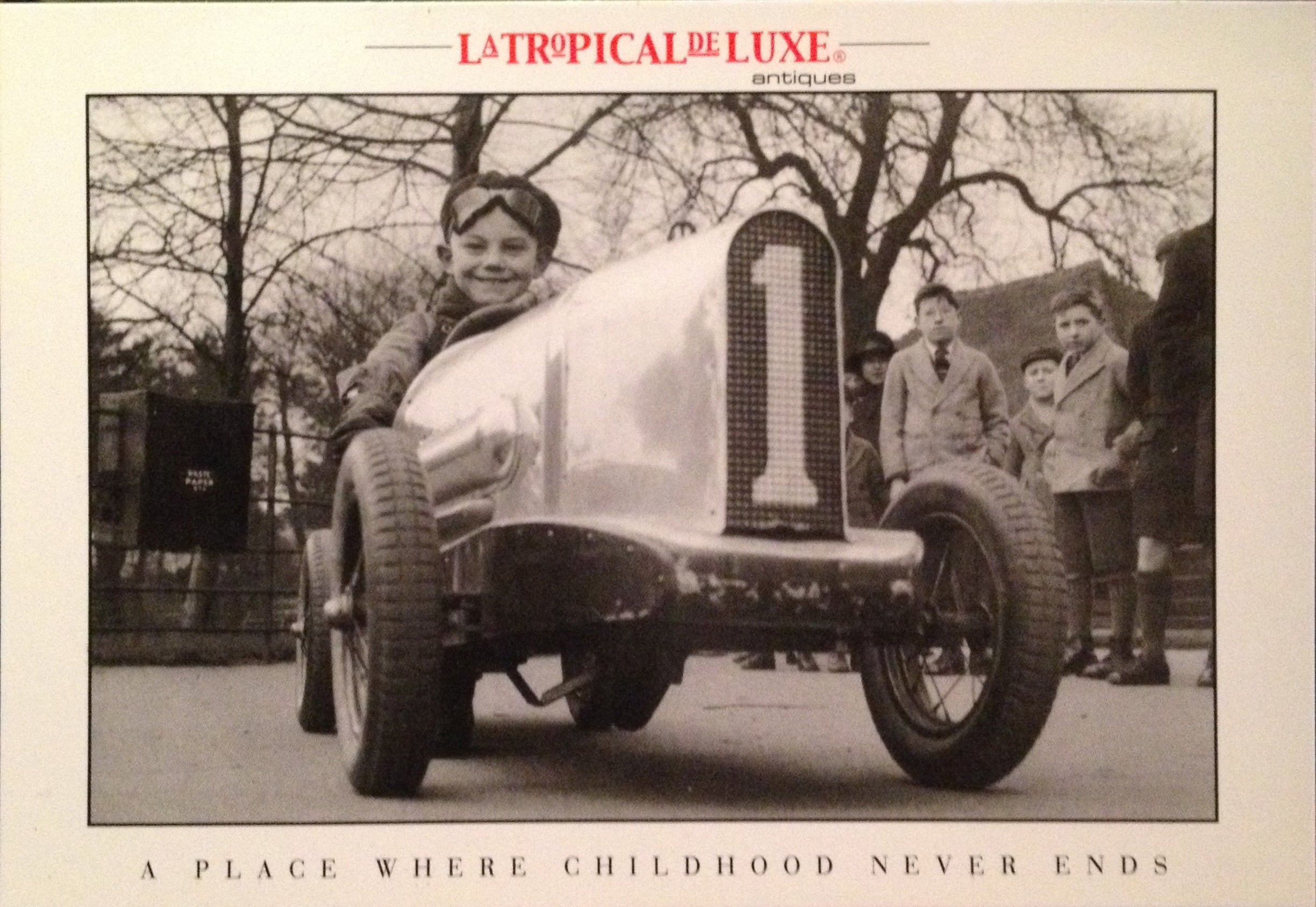
About the Seller
4.9
Vetted Professional Seller
Every seller passes strict standards for authenticity and reliability
Established in 2002
1stDibs seller since 2016
324 sales on 1stDibs
Typical response time: 1 hour
- ShippingRetrieving quote...Shipping from: Buenos Aires, Argentina
- Return Policy
Authenticity Guarantee
In the unlikely event there’s an issue with an item’s authenticity, contact us within 1 year for a full refund. DetailsMoney-Back Guarantee
If your item is not as described, is damaged in transit, or does not arrive, contact us within 7 days for a full refund. Details24-Hour Cancellation
You have a 24-hour grace period in which to reconsider your purchase, with no questions asked.Vetted Professional Sellers
Our world-class sellers must adhere to strict standards for service and quality, maintaining the integrity of our listings.Price-Match Guarantee
If you find that a seller listed the same item for a lower price elsewhere, we’ll match it.Trusted Global Delivery
Our best-in-class carrier network provides specialized shipping options worldwide, including custom delivery.More From This Seller
View AllArt Nouveau Sterling Silver Flower Vase, William Hutton & Sons, c. 1903
By William Hutton & Sons
Located in Buenos Aires, Olivos
William Hutton & Sons. London, Birmingham & Sheffield. circa 1903.
An exceptional Art Nouveau silver and vase by William Hutton dated 1...
Category
Early 20th Century British Art Nouveau Sterling Silver
Materials
Sterling Silver
Barovier Toso Italian Vintage Art Glass Rostrato Murano Vase / Bowl, circa 1938
By Ferro Toso Barovier, Ercole Barovier
Located in Buenos Aires, Olivos
Barovier Toso Italian vintage art glass Rostrato Murano vase / bowl, circa 1938
An exquisite mid-20th century centrepiece by Barovier & Toso in b...
Category
Mid-20th Century Italian Mid-Century Modern Glass
Materials
Murano Glass
$1,760 Sale Price
20% Off
Flavio Poli Large Sommerso Murano Glass Vase by Seguso, 1960
By Flavio Poli
Located in Buenos Aires, Olivos
Here is a wonderful 1950/60's Murano glass vase, made on the island of Murano, near Venice, Italy. In a stunning combination of Green glass encased in clear glass, using the renowned...
Category
Mid-20th Century Italian Mid-Century Modern Vases
Materials
Murano Glass
Art Nouveau Flowers Champagne / Wine Bucket Cooler, 1900´s
Located in Buenos Aires, Olivos
Art Nouveau Flowers Champagne / Wine bucket cooler. 1900´s.
Flowers design. Very Nice and unique cooler.
We have specialized in the sale of Art Deco and Art Nouveau and Vintage styl...
Category
Early 20th Century French Art Nouveau Barware
Materials
Brass
Barovier & Toso Murano Clear and Light Blue ¨Rostrato¨ Glass Vase, Italy, 1950´s
By Barovier&Toso
Located in Buenos Aires, Olivos
Barovier & Toso Murano Clear and light blue Rostrato glass vase, Italy, 1950s
Vintage / mid-century / Art Deco Blue Murano art glass vase made with...
Category
Mid-20th Century Italian Mid-Century Modern Vases
Materials
Murano Glass
Alfa Romeo Car Racing Trophy Murano Glass Vase / Cup by Flavio Poli for Seguso
By Flavio Poli, Seguso Vetri d'Arte
Located in Buenos Aires, Olivos
'Alfa Romeo' glass coupe
Flavio Poli for Seguso Vetri d'Arte, circa 1950s
Wonderful blue cup Alfa Romeo by Flavio Poli for Seguso.
Hand blown Murano glass.
Fantastic Piece of Automob...
Category
Mid-20th Century Italian Mid-Century Modern Vases
Materials
Murano Glass
You May Also Like
An art nouveau wine glass from the Cologne Ehrenfeld glassworks, ca. 1902
Located in Aachen, DE
A wonderful art nouveau - Jugendstil design from Cologne made in circa 1902 by the Rheinische Glashuetten AG Koeln-Ehrenfeld. The company executed works by famous designers like Pete...
Category
Antique Early 1900s German Art Nouveau Glass
Materials
Glass, Art Glass, Blown Glass, Optical Glass, Uranium Glass
An art nouveau wine glass from the Cologne Ehrenfeld glassworks, ca. 1902
Located in Aachen, DE
A wonderful art nouveau - Jugendstil design from Cologne made in circa 1902 by the Rheinische Glashuetten AG Koeln-Ehrenfeld. The company executed works by famous designers like Pete...
Category
Antique Early 1900s German Art Nouveau Glass
Materials
Glass, Art Glass, Blown Glass, Optical Glass, Uranium Glass
Otto Prutscher Glass
By Otto Prutscher
Located in Mérida, YU
Extraordinary collectible Drinking Glass in perfect condition attributed to Otto Prutscher.
Manufactured in 1906 by Meyr's Neffe in Vienna Austria.
This design is now in the permanen...
Category
Early 20th Century Austrian Jugendstil Glass
Materials
Art Glass
$6,400 Sale Price
20% Off
Otto Prutscher Glass
By Otto Prutscher
Located in Mérida, YU
Extraordinary collectible Drinking Glass in perfect condition attributed to Otto Prutscher.
Manufactured in 1906 by Meyr's Neffe in Vienna Austria.
This design is now in the permanen...
Category
Early 20th Century Austrian Jugendstil Glass
Materials
Art Glass
$8,000
Rare red optically blown art nouveau wine glass by Emile Gallé, Nancy, ca. 1903
By Émile Gallé
Located in Aachen, DE
This design was exhibited at the 1903 l'École de Nancy Exposition at pavillon de Marsan in the palais du Louvre, following an initiative by l'Union centrale des arts décoratifs. Sho...
Category
Antique Early 1900s French Art Nouveau Glass
Materials
Glass, Art Glass, Blown Glass, Optical Glass, Uranium Glass
An art nouveau Liqueur glass from the Cologne Ehrenfeld glassworks, ca. 1902
Located in Aachen, DE
A wonderful art nouveau - Jugendstil design from Cologne made in circa 1902 by the Rheinische Glashuetten AG Koeln-Ehrenfeld. The company executed works by famous designers like Pete...
Category
Antique Early 1900s German Art Nouveau Glass
Materials
Glass, Art Glass, Blown Glass, Optical Glass, Uranium Glass
More Ways To Browse
Josef Hoffmann Wiener Werkstatte Silver
Bohemia Red Glass
Bohemia Wine Glasses
Baccarat Highball Glasses
Baccarat Talleyrand
Baccarat Vega Glasses
Blenko 6427
Blenko Crackle Glass Decanter
Blenko Genie
Bubble Drinking Glasses
Cenedese Geode
Champagne Coupe Pink
Champagne Saucers
Chianti Vintage 1970
Cobalt Blue With Gold Decanter
Crystal Sherbet Glasses
Cut Glass Butter Dish
Cut Glass Finger Bowls
